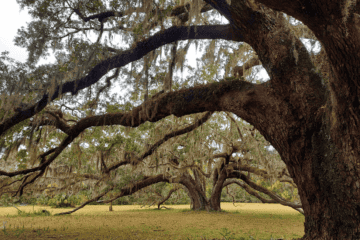Piebald Deer: The “Unicorns” of Cumberland Island
I spotted it. I had always hoped to but never thought it would actually happen.
Last week on Cumberland Island, I saw a pure white piebald deer.
So what is a piebald deer and why should you be as excited as I am? Read on to find out.

A piebald deer is a rare type of white-tailed deer which has various amounts of white hair and can even be completely white.
The origin of the word “piebald” comes from the magpie’s black and white plumage and “bald” in the obsolete sense, meaning “streaked with white.” Piebaldism is a genetic mutation in which there is an absence of melanocytes, or mature melanin-forming cells, in skin and hair. This leads to a lack of pigmentation in certain places on the body. Unlike albino deer which have no pigment, red eyes, and pink or white hooves, piebald deer have brown eyes, dark hooves, and small patches of white or almost pure white hair, similar to a pinto horse.
Not only deer may be piebald; this inherited genetic trait occurs in almost all mammals and is very common in mice, rabbits, dogs, sheep, cattle, and horses. Piebaldism in humans exists, as well; it has been documented to occur equally in both sexes and all races. It occurs very rarely in humans, with an estimated incidence of less than one in 20,000 individuals.
Piebald deer are extremely rare, too. Less than two percent of all white-tailed deer are piebald, although some researchers claim this number is less than .02 percent. Research on these deer is limited, making a definitive answer on their numbers unclear.

Piebaldism is a recessive trait; it is believed that both parents must carry the recessive gene to produce piebald fawns. It is also possible for a piebald doe to bear normal fawns.
Unfortunately, piebaldism can come with health problems. Piebald deer may have short or crooked legs, a shortened lower jawbone, an arching spine, internal organ deformities, deformed hooves, or bowing of the nose. This is because some of the same genes that code for coat color also code for other physical traits.
Some deer may be born with several or all of these health issues, while others may have none and be completely healthy. Most piebald animals are born with symptoms that do not affect their day-to-day quality of life. Because deer especially are resilient animals, even those with abnormalities normally learn how to adjust.
Although researchers still do not totally understand the genetic misfire that produces piebald deer, they do know you should consider yourself lucky if you see one in the wild. Even avid outdoorsmen may find them only once in a lifetime.
Piebald deer are protected from hunting in many regions. Georgia does not have any laws prohibiting hunting them, but if you are superstitious, you may not wish to. Legend has it that killing a piebald buck during a hunt curses the hunter, while some European cultures even believe those who kill a piebald deer will die within a year.

By contrast, many Native American tribes venerated piebald deer, believing them to be the embodiments of spirits passing to or from the spirit world. Seeing a piebald deer portended a time of transition so killing piebald deer was prohibited to ensure this transition occurred. This reverence for the piebald deer still prevails in some Native American cultures today. In fact, some researchers believe the only reason piebald deer are not extinct is because of Native Americans’ preservation efforts over the centuries.
How fortunate are we that Cumberland Island’s South End has a small population of these unique and dazzling creatures! If you manage to spot one while on the island, I guarantee you will realize for yourself why they have taken on a mythical status over the centuries.
Learn more about Cumberland Island’s ecology and history on our Cumberland Island Walking Tour!


